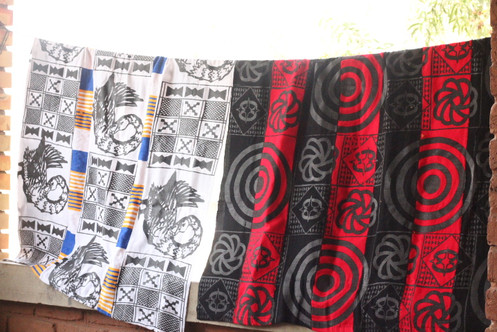Cut From the Finest Cloth
- Mich the World Citizen
- Jan 29, 2020
- 5 min read
Updated: Feb 5, 2020
Ankara, Kitenge, Kanga, Wax Prints, Tissue, Bogolan, Mudcloth, Adire, Kente, Barkcloth, Shweshwe, Batik, Baoule....
Many of the African textiles sewn into some of our favorite IG and Pinterest worthy 'fits and accessories are known for their vibrant colors and variety of stunning designs. But did you know that many of these fabrics have their own unique history and meaning? The techniques and cultural significance varies between each region, tribe, social class, etc., and there are a lot of interesting details behind these designs.

Weaving has extremely deep roots in ancient civilizations all across the globe. From plant fibers to animal furs, humans have found several ways to create the various forms of cloth as
we know it today.

With the advancement of technology and chemistry, each step has gotten a little less difficult and time consuming, which gives textile designers much more time to focus on creating all of the intricate patterns and color combinations that we now see. Some of the most popular designs that catch our eyes in modern fashion come from West Africa, like the Kente print. Traditionally, Kente is known to be the cloth of royalty, and is usually meant to be worn during important events and times of celebration. The Akan people of Ghana are the creators of this famous design, and the name comes from the word kenten, meaning basket in the Asante language. Depending on who you ask, the Ewe (also Akan people) claim that it derives from the word Kete, a combination of ke and te, meaning to open and press (imagine the motion of weaving on the loom) in their language. Over the years as I visited Ghana, I've gotten the opportunity to travel to some of the places where these traditional methods are still practiced today. Much like choosing names at birth in many cultures, there's significant meaning behind the colors, shapes, and patterns that are woven into each piece.
At the Ntonso Village in Kumasi, my cousin Ahkil and I got a chance to learn some really cool history about one of my favorite methods of textile design-- stamping! The Adinkra symbols (pictured above) are often representative of different aspects of life, nature, and some proverbial wisdom.

The symbol Asase Ye Duru, for example, means 'the Earth has weight,' or represents the divinity of Mother Earth (Akan goddess, Asase Yaa) and the importance of respecting and preserving it. Asase's male counterpart, Nyame, is the Sky God, and the symbol, Gye Nyame, represents the supremacy of God.

This region is still responsible for producing and supplying most of the authentic adinkra fabric for the surrounding areas, and there are plenty of shops and artisan markets to visit when you want to shop for the real deal (support local artists). My new friend, Anderson, at the Adinkra Village showed us the traditional process of carving each design by hand from calabash or wood, as well as how the ink is made (pictured above) from a special type of tree bark. It first gets soaked overnight, then pounded into powder form to be mixed with water, then boiled for several hours until it's reduced to a permanent natural dye.
Since the beginning of time, our ancestors have used natural resources and science to create all types of vibrant hues for drawing, painting, and dyeing. This leads me to another technique that is very popular around the world and dates back to at least the 1st century where evidence has been discovered in Egyptian tombs. Batik is a wax-resist technique; meaning that a design is drawn or stamped onto the cloth using a dye resistant substance (wax) before the entire piece of fabric is submerged in a dye bath. Once the pigment has penetrated the fibers and stains the fabric, it is then boiled to remove the wax, and the resist (design) is left unstained. This style of textile design is found all around the world, and while they may share much of the same method, the materials and tools are just as special as the people they touch. In countries like Nigeria, Senegal, Ghana, and Mali, the resist was created using other natural resources such as mud, and rice and cassava starches. When you get to places like India, Japan, Thailand, and Malaysia, plant resins and beeswax (or other types of waxes) are used, and the tools also reflect the access to materials in the region. Over time, the art of batik has traveled and been mastered in locations such as Java, Indonesia, where you can marvel at all the intricate designs.
Speaking of Indonesia, many*of the African wax print designs that we know and love were actually originally created for the Indonesian market. During the industrial revolution, a Dutch textile businessman noticed the demand for printed cotton fabrics over in Indonesia, and thought to produce these colorful designs at his textile factory in the Netherlands. The invention of new textile machinery that made the tedious processes of batik and block printing allowed for fast and plentiful production. However, this idea wasn't widely accepted in the community it was intended for because it didn't have the same authentic feel (and smell) that the traditional process provides. However, it immediately took off in West Africa** and across the African continent, and they began to apply new meanings to the designs.

Much like the Kente cloth, wearing specific designs and colors have been associated with times of celebration such as weddings, funerals, political events, etc. One of my favorite prints is called Nsubra, which means water well in Twi, as the design resembles the ripple effect of water when a stone is tossed into it.

In East African countries such as Tanzania and Kenya, another version of this fabric has its own special qualities and importance. Kanga or Kitenge is often given as a gift or for some particular reason where the printed message can relate to the person or event. The picture above is an example of Kanga from Zanzibar, Tanzania, where the message in swahili translates to "Thank you, mom, for your good upbringing." Then of course, there are many prints and designs that are made and worn for the sake of fashion and fun!
I've been collecting these fabrics since I first started traveling the world, starting with sarongs from Hawaii. As an artist, I feel even more responsible and invested in protecting the integrity of original art forms, and this includes being more conscious of my involvement in the capitalist mode of production which continues to kill the local economies around the world...the artisans who have families to provide for. While new machines create a more swift process and mass production, artisan work is still much appreciated and valued by many. Let's remember to #supportlocalartists #localbusiness and #smallbusiness in your area and beyond! The textiles distributed around the continent are still widely produced by European and Asian factories, but there are some local African companies who are making names for themselves in recent years. I make a conscious effort to also support these brands, and I challenge you to do the same! This is how we #grow.

Welcome to my TED talk, it's been real!

**What's the connection between the Netherlands and Indonesia & West Africa? Indonesia was colonized by the Dutch until 1945. The Dutch had also been established traders along the Gold Coast between the 15-17th centuries-- everything from natural resources such as cotton, gold, and rubber... to human resources. They were responsible for transporting many African people for slave labor in Europe, America, and the Caribbean.
Please Like & Share if you enjoyed this post. PEACE!

































Comments